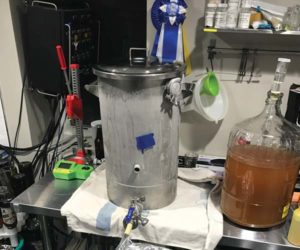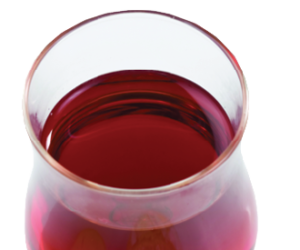Late harvest wines are made using grapes affected by the mold Botrytis, which dehydrates the grapes. We’ve pooled advice from three pros with numerous accolades for their dessert wines to help you make an award-winning late harvest wine at home.
Joe Hudon is entering his 5th harvest as the Winemaker at Claar Cellars, an estate winery atop the White Bluffs area of the Columbia River in Pasco, Washington. Joe has been in the wine industry since 2001, working domestically at wineries in Washington and California, as well as at wineries in New Zealand and Australia.
We use Riesling grapes for our late harvest and icewines because it provides the right balance of fruit, sweetness and acidity. The fruit often contains apricot, dried figs, dried apples, harvested wheat, and nutty aromas and flavors. We leave the grapes out until they begin to fall off the vine or achieve a minimum of 25 °Brix and look for the flavor profile to shift from fresh, floral notes to the decadent dried/jam-like fruit notes.
With riper fruit comes increased protein content, Botrytis mold, bunch rot, and decreased yields. We thus need to treat the grapes differently than dry table wine. There is a double-edged sword involved in that there is enzymatic oxidation in combination with high unstable protein concentration. I play around with the oxidative (no SO2 at juice stage) versus reductive (SO2 or other antioxidative products) processing of fruit to see what works best. Using the reductive process retains more fruit flavor and aroma at the juice stage but you remove some of that when fining out the high concentration of unstable proteins with bentonite. I have found there are enough flavor and aroma compounds to treat the pressings oxidatively.
We press these grapes much heavier than our dry wine styles. Once the wine is pressed to the tank I add SO2 to stop oxidation and use a combination of settling enzymes, bentonite and PVPP to settle and remove the unstable proteins. Once the wine is settled, we rack the juice to a fermentation tank where I use a strong yeast strain to ferment it.
Greg Allen is the Winemaker at Dolce Winery in Oakville, California.
We make late harvest wines mostly with Sémillon, but also Sauvignon Blanc. I’m looking for grapes that are wimpy in the face of fungal attack but can withstand the effects of a prolonged hang time.
Late harvest winemaking is different. First, recognizing that the winemaking can’t happen unless we have the proper concentration, we allow for the development of mold in the vineyard. The vines are trellised in a fashion that promotes the growth of mold. Second, the “pre-fermentation blending” process is decidedly important in making for a successful fermentation and resultant wine. The tanks of juice produced from each day’s harvesting efforts normally exhibit a wide range of sugar concentration — from 28 to 42 °Brix. It’s my belief that the most balanced, stable, and delicious wines are produced from juices of 34 °Brix prior to fermentation. To that end, the juice batches from each day of harvest are blended to achieve that goal. Third, every fermentation batch must be a stuck fermentation in order to produce a wine of balance between alcohol, residual sugar and natural acidity. Fourth, the individual fermentation batches reside in barrel for three years prior to blending and bottling. This allows for the elevation of flavors from yeast-driven to fruit-driven and the transformation in color from pale to golden. Rarely does any one batch exhibit all the characteristics I strive for in Dolce, so the wine we make each year is always a blend of the 15-20 fermentation batches of the vintage.
I use several different yeasts, some commercially available as well as allowing the “natives” to conduct their own fermentation (these are uninoculated). Some batches ferment too far and taste alcoholic and others don’t ferment far enough and taste like a syrup.
David Breeden is the Wine-maker at Sheldrake Point Winery in Ovid, New York and has gained experience at wineries throughout the Finger Lakes region. Armed with two degrees in chemistry and two in philosophy, Dave not only brings expertise to the wine lab and on the crush pad, he also can be heard waxing poetic virtues of everything from Plato’s cave to contemporary third-party politics.
Traditionally I make my late harvest wines using only Riesling, but this year we tried Gewürztraminer as well. What you are looking for to make a late harvest wine are grapes from a white aromatic varietal that have nice Botrytis.
Late harvest wine is all about Botrytis. We can’t make one every year; the last two vintages for late harvest Riesling were 2008 (“Best Sweet Riesling in the World” at the 2010 Canberra International Riesling Challenge) and 2013 (“Best American Riesling” at the 2013 CIRC), and this has been the only year for late harvest Gewürztraminer.
Botrytis is more likely with excessive rain, but it’s not just about that. Even with lots of rain, you can have just crappy Botrytis, or just sour rot. For us, it’s not about the weather so much as the individual disease incidence.
Generally our late harvest grapes are picked in late November, though the 2013 late harvest Riesling was harvested in January from grapes grown in 2012 (the government requires that the vintage year be the year of harvest). Generally it’s few enough grapes that we do it all in one pass.
For dessert wines I use Laffort VL-1 yeast. I also, for wines over 30 °Brix, start by adding water to 1 gallon (4 L) of juice to get a Brix around 25, and add the yeast to that. I then incrementally add juice as the wine ferments, always keeping the Brix between 20 and 30. This keeps the yeast happier.
For home winemakers, the key is going to be the grapes. Try to develop a relationship with a local grape grower, and hope for the best!






